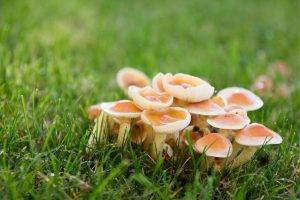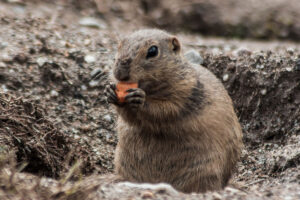It’s well known that mushrooms are a delicious and healthy food source. They are rich in protein, fiber, and antioxidants as well as can lower the risks of heart disease, diabetes, and Alzheimer’s. This fungus grows easily in woods, on grass after heavy rains, and even in your backyard compost pile. So it is normal to wonder: can I eat mushrooms from my yard? It would definitely save you a trip to the store!
But before you start making mushroom stew, read this article first. It covers answers to all your questions about foraging wild mushrooms from your yard.
Can I Eat Mushrooms From My Yard?

Not all of them. There are dozens of mushroom species. While most found on your lawn are probably safe to eat, there are still at least 1 percent of mushrooms that are toxic and dangerous to your health. Overall, mushrooms can be categorized into three types:
- Edible: completely safe to eat and most nutritious
- Non-edible: they won’t kill you, but you can become sick with stomach pains or vomiting symptoms
- Poisonous: very dangerous to eat and can lead to organ failure and death
The best way to know if the mushrooms growing in your yard are edible or not is to do proper research to identify what type of mushroom it is. Be cautious because sometimes the edible ones look very similar to those you don’t want to be eating. Misidentification is a common reason why people become harmed from eating wild mushrooms, so always ask a trained expert plus check and double-check your research.
Are white mushrooms in my yard edible?
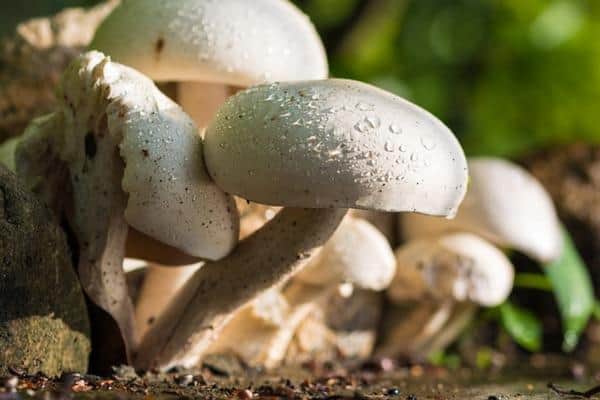
It’s possible they are, but there’s no way to know without identifying the species. Plenty of white mushrooms are edible. However, there are also dangerous lookalikes growing alongside edible species. This is why eating backyard mushrooms can be very dangerous, and something you probably shouldn’t try unless you know what you’re doing.
Typically toxic mushrooms will have white gills that can be found under their top (or caps) or other bright colors. For example, the yellow-staining mushroom (Agaricus xanthodermus) is white but has a yellow stain in the stem when cut. These mushrooms can cause stomach problems if eaten.
The most common white mushroom that grows on well-cared-for lawns without weeds is the Saproamanita thiersii (formerly Amanita thiersii). This species with no common name is edible and distinguishable by the white spore prints on its cap that make it look fluffy. However, in heavy rains, these prints may be washed away. The gills underneath the cap can have a light brown shade to them.
Other edible white mushrooms you may come across include:
- Fairy ring mushrooms (Marasmius oreades) grow in a circle and can be white with well-spaced gills
- Meadow or field mushrooms (Agaricus campestris) that have white caps with pink gills
- Giant puffballs (Calvatia gigantea) are edible when young and the inside flesh is also white but toxic when they mature to have a greenish-brown inside
How can you tell if mushrooms are safe to eat?
Every species comes in different shapes and sizes, sometimes even changing color depending on the weather or their maturity level. Since some wild mushrooms are dangerous enough to lead to organ failures and death, it’s best to always examine mushrooms before you eat them.
Do your research thoroughly on 2 or 3 edible species growing in your region and look for only them to pick. Also, make sure to have some knowledge of their potential dangerous lookalikes.
However, if you do come across different species, here are some basic guidelines to identify if they are poisonous. Toxic mushrooms typically have:
- White gills
- A ring of color around their stem
- A volva, is a cup-like structure at the base of their stem
- Red or bright orange on their cap or stem
What are some other mushrooms that are edible?
Besides those previously listed in this article, here’s a list of 4 more common species of wild mushroom that are edible:
- Hen of the wood (Grifola frondosa) they are found at the base of trees, grow in large clumps, and look coral-like with greyish-brown caps that are curled
- Black trumpet mushrooms (Craterellus cornucopioides) typically grow in leaf litter and are black, grey or dark brown with a smooth underside
- Chanterelle (Cantharellus cibarus) are golden or yellow mushrooms that are meaty and funnel-shaped with ridges along the stem
- Morel mushrooms (Morchella esculenta) are easy to spot with their wrinkled, “honeycombed” cap that’s brownish or yellow-grey
Are mushrooms poisonous to touch?
No, mushrooms are not poisonous to touch. However, the toxic species can be deadly with just one bite. For this reason, it is okay to pick a mushroom and examine it closely to figure out if it is an edible species or not.
Sometimes you might even want to cut it open to see what the color of its inside flesh or stem looks like to identify it. If you are unsure of what species you found, it’s best to show the mushroom to an expert for further identification before you eat it.
What are the most poisonous mushrooms?
While you can recover from an inedible mushroom, stay away from poisonous ones or one of these 4 dangerous mushrooms that can lead to organ failure.
Destroying angels mushroom (Amanita virosa)
This mushroom is one of the deadliest in North America, with symptoms coming up quickly within 24 hours. Eating them can lead to convulsions, kidney and liver failure, and death.
The cap can be white or tan, yellowish, or pinkish at the center with white edges. When young, they look rounded and are easily mistaken for puffballs.
Death cap mushroom (Amanita phalloides)
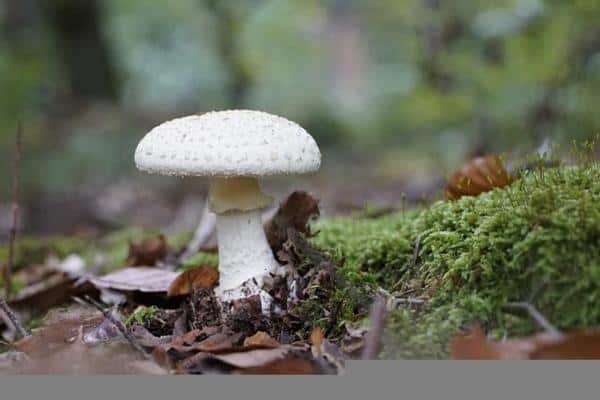
As its name suggests, it’s a dangerous mushroom that can lead to cramping and liver failure. This mushroom also looks a lot like regular white mushrooms making it a common culprit for misidentification. However, they can also be a pale green, yellow, olive green, or brown color.
Conocybe filaris mushrooms
These mushrooms have smooth, cone-shaped caps that are brownish, are extremely toxic, and can cause death. They mostly grow on lawns, look a lot like edible species, and are common in the Pacific Northwest.
Fly agaric mushroom (Amanita muscaria)
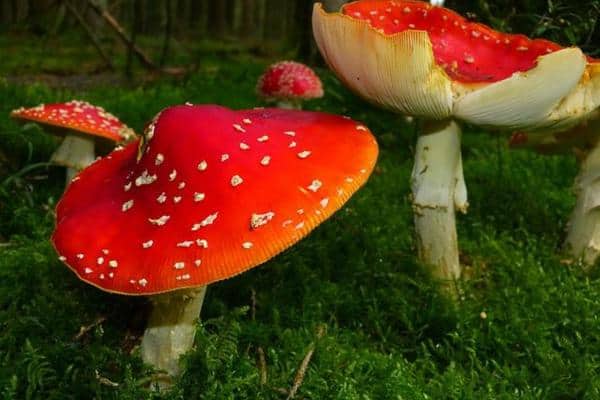
This is a notorious red mushroom that is known for its hallucinogen properties brought out from its toxins. In large doses, these “magic mushrooms” can kill you.
Conclusion
The answer to whether you can eat wild mushrooms is yes and no. While most mushrooms found in your yard are edible, there is always a slim chance that a poisonous species sprouted up alongside them. You should always examine the mushrooms closely and properly identify them before eating.
All in all, if you have any doubt, throw it out!

